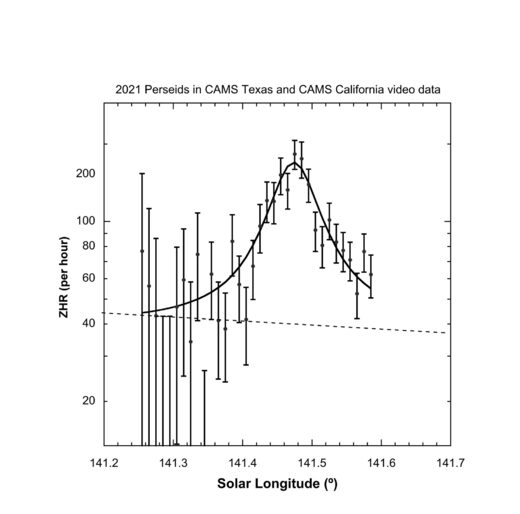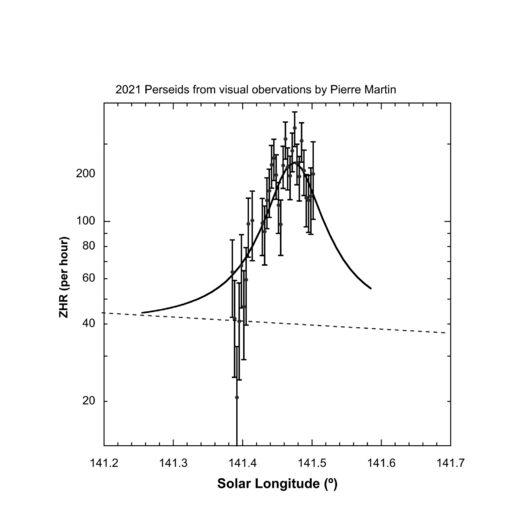
An unexpected outburst of Perseids was detected by low-light video observations on August 14, 2021. This outburst was not anticipated from known 109P/Swift-Tuttle dust trail encounters.
The outburst peaked at solar longitude 141.474 ± 0.005 degrees (equinox J2000.0) and the activity profile had a Full-Width-at-Half-Maximum of 0.08 degrees solar longitude and a peak rate of ZHR = 130 ± 20 per hour above the normal ~45 per hour annual Perseid activity.
The Perseids had a steeper magnitude size distribution index than the normal annual shower component. The activity profile is similar to that derived from visual and forward meteor scatter observations. This activity may be related to the earlier smaller enhancements observed in 2018 and 2019.
This meteor cluster was captured in the sky over Japan about a month ago:
Meteoroid clusters are so rare that only a few cases have been reported so far since the phenomenon was first identified during the Leonid meteor shower in 1997…
Here a stunning Perseid meteor over Spain:
In 2018, visual observers reported a narrow peak of Perseid shower activity around solar longitude 140.95°, about ~30 hours after the traditional Perseid maximum, with a peak of about ZHR = 25 per hour above the normal Perseid activity of ZHR ~ 45 per hour at that time (Miskotte 2019).
In 2019, a similar peak was recorded by forward meteor scatter observations collected by the International Project for Radio Meteor Observation. That year, the outburst peaked at solar longitude 141.02° with a peak ZHR ~30 per hour above normal activity (Miskotte 2020a; 2020b).
CAMS Low-light video observations
The Perseids are best observed from the northern hemisphere. The 2021 outburst happened between 6h and 12h UTC on August 14, 2021, at a time best suited to the CAMS video-based meteoroid orbit survey networks in the United States.

The networks triangulated meteors using low-light video cameras and determined the meteor’s radiant and speed in a continuous night time surveillance. The weather was mostly clear for networks in Texas (coordinated by W. Cooney and including D. Selle, F. Cyrway and J. Brewer) and California (P. Jenniskens, D. Samuels, J. Albers, E. Egland, B. Grigsby and J. Wray). CAMS Mid-Atlantic (coordinated by P. Gural), CAMS Florida (A. Howell), CAMS Arkansas (L. Juneau) and LO-CAMS in Arizona (N. Moskovitz) also observed some of the meteors under partial clear skies (c.f. CAMS-website for date of August 14).
Early results from the new CAMS Texas network in mostly clear skies and the CAMS California network in clear skies show an activity profile with peak Zenith Hourly Rate ZHR = 130 ± 20 per hour on top of normal ZHR = 40-45 per hour annual Perseid activity (Figure 1).
The Full-Width-at-Half-Maximum of the fitted Lorentzian profile is 0.08 ± 0.01 degrees solar longitude. The peak occurred at solar longitude 141.474 ± 0.005 degrees (equinox J2000.0), corresponding to 8.2h UTC on August 14. The combined magnitude distribution index was 3.59 ± 0.36, compared to 2.94 ± 0.04 for the annual component in other years at this solar longitude.
Comparison to other observations
Pierre Martin, visually observing from Ottawa, Canada, reports “multiple Perseids per minute with many bursts, sometimes 3-4 in a second,” starting at 6h UTC. He observed until 9h UTC, under clear skies with star limiting magnitude 6.7.

From his 5-minute interval counts, we calculated a peak ZHR = 210 ± 20 per hour at solar longitude 141.474 ± 0.005 deg. The visually observed meteors follow the video data profile well.
Strong outburst Perseids on August 14, 2021 ~ 06-09 UT! – https://t.co/9DldzizDj6
Just in: Canadian meteor observer Pierre Martin just observed a strong Perseid outburst. He reported to the author: “I just witnessed very strong Perseids activity Aug 13/14 06-09 UT. Multip… pic.twitter.com/VgZmOeffZK— MeteorNews (@eMeteorNews) August 14, 2021
This outburst was also confirmed by radio forward meteor scatter observations posted by H. Ogawa of the International Project for Radio Meteor Observation.
A compilation of rates from 49 observers in 14 countries saw the detection count increase above normal levels after 6.4h UTC (141.40 deg solar longitude), and peak at about 8.8h UTC (141.49 deg) at a level of 3 times the Perseid peak level, before declining to normal levels at 12.5h UTC (141.65 deg solar longitude). Combined Zenith hourly rates peaked around ZHR = 210 per hour, in good agreement.
More confirmation coming in of the #Perseid meteor outburst that occurred yesterday morning.
It happened during daylight hours here in the UK (so would’ve been invisible) but radio meteor detection systems here can still spot such events. Congrats @markmac99!
cc @IMOmeteors https://t.co/SdGwlMv3jR
— Will Gater (@willgater) August 15, 2021
Mysterious cause of 2021 Perseid outburst
The outburst can not be identified yet with a known dust trail crossing from 109P/Swift-Tuttle. On the other hand, the width of the outburst is similar to that of past Perseid Filament returns.
The Filament is thought to be an accumulation of dust in mean-motion resonances from many past returns. That could perhaps mean that this dust was directed into Earth’s path this year. [Meteor News]
Now subscribe to this blog to get more amazing news curated just for you right in your inbox on a daily basis (here an example of our new newsletter).
You can also follow us on Facebook and/ or Twitter. And, by the way you can also make a donation through Paypal. Thank you!
You should really subscribe to QFiles. You will get very interesting information about strange events around the world.














Hmmm, too bad we had clouds out here in the mountains. Normally, when clear, the entire Milky way is visible, like when you go camping.
Had high expectations, but monsoons hosed it all up.
On a good note, I did plant another cherry tree too, at night, after it rained hard. That’s a secret trick. That way, sun doesn’t shine on roots when you unpack the tree and break up the bottom, so roots can easily grow out.
If you don’t do that, sometimes the tree roots will retain the shape of the container, and spin around eventually strangling the tree.
Always pre-dig tree holes extra big and extra deep. Saturate the holes with egg shells, bones, organic mulch, top soil, leaves, twigs, and chicken poop for a couple of months before you plant a tree. Water the hole intermittently for a couple weeks before planting too. It leeches the organic matter down where the roots will grow.
Tree prices went way up around here, so may as well do everything I said, and you will have success. I love cherry trees, and they grow well on my land. Bugs like them, so spray the Sevin bug killer on leaves. Repeat after rains.
Malathion spray too, twice a year. That kills the wood boring bugs, moth larvae, and beetles. Go light mist, and not too much.
Add a half a bag of red bark mulch on top after planting, then water the basin deep.